 George Deforest Fowler
George Deforest Fowler
George Deforest Fowler, 68, formerly of South Hero, Vt., died Dec. 6 at Orange Regional Medical Center in Middletown, N.Y. At the time of his death Fowler and his fiancée were living in Pennsylvania while building a house near Lake Placid, N.Y.
Fowler owned and ran The Islander of South Hero for 34 years, before selling the newspaper and retiring in December 2016. Under his guidance, the Islander grew in size, circulation, advertising, and significance to the community. At the time of his retirement, the paper sold about 4,500 copies weekly in 13 towns in Vermont and New York.
Fowler was an active member of the Vermont Press Association and a former member of the New England Newspaper and Press Association.
Fowler leaves two sons, George and Jason; a fiancée, Renee Hoover; five granddaughters; two siblings.
Jean Davis Bigelow
Jean Davis Bigelow, 92, of Woods Hole, Mass., died Nov. 27 in Woods Hole.
Bigelow and two friends and colleagues, Pat Capone and Inga Tufts, established the Southborough (Mass.) Villager, now the Northborough-Southborough Villager, in the late 1970s. Jean was the founding editor and publisher. They eventually sold the newspaper.
Bigelow was secretary and later president of the Southborough Planning Board.
She leaves a son, John; a daughter, Carol; four grandchildren, Nathaniel, Benjamin, Dara and William.
Robert George Wilmers
Robert George Wilmers, 83, of New York City, died Dec. 16 at his home.
Since May 2016, he had been a co-owner of New England Newspapers Inc., based in Pittsfield, Mass., which encompasses the Brattleboro (Vt.) Reformer, the Bennington (Vt.) Banner, the Manchester (Vt.) Journal, and The Berkshire Eagle of Pittsfield, Mass.
He leaves a wife, Elisabeth; a son, Christopher; four stepchildren, Camille, Guillaume, Juliette and Charlotte; two grandsons; 11 step-grandchildren; his first wife, Gertrude.
James A. Barbato
James A. Barbato, 74, of Sterling, Mass., died Dec. 30 at Saint Vincent Hospital in Worcester, Mass., after a brief illness.
Barbato and his wife, Ann, owned the Sterling Meetinghouse News.
Besides his wife, he leaves three sons, Mark, Steven and Brian; four grandchildren; a brother; a sister.
Stephen ‘Steve’ Riley
Stephen “Steve” Riley, 90, of Meredith, N.H., died Jan. 7 at his home after a time of declining health.
After graduating from college in 1950, Riley began his more than 40-year newspaper career at the then-Brunswick (Maine) Record before moving to the Portsmouth (N.H.) Herald, where he covered York County, Maine.
He later briefly joined the former Bangor (Maine) Daily Commercial and then the Portland (Maine) Press Herald as its Bangor correspondent.
Riley spent 30 years at the Portland Press Herald and Maine Sunday Telegram of Portland, first as a feature writer for the Sunday Telegram. He eventually became managing editor of the newspapers. In the mid-1980s, he became editor at the Central Maine Morning Sentinel of Waterville, where he remained until his retirement in 1990.
Riley spent several years on the board of the New England Society of Newspaper Editors and a year as its president. He was named Maine Journalist of the Year in 1989 by the Maine Press Association. He received the Yankee Quill Award in 1994 for outstanding service to New England journalism. He also had been inducted into the Maine Press Association Hall of Fame.
Riley took part in an exchange program with Russian journalists in the 1980s, and was a member of New England Society of News Editors delegations that traveled to the Soviet Union. The society also hosted Soviet journalists in New England four times.
“My father always wanted to be a reporter,” his son, Stephen W. Riley, said in his father’s obituary in the Press Herald. “He had this innate sense of curiosity. His interest in journalism wasn’t as grandiose as making the world a better place, but more that he liked keeping people informed.”
Riley said his father was a “tough but fair editor.”
“He was not a yeller or a screamer,” his son said. “He got his point across, but he did it in a very benevolent way.
“He always took the straight-down-the-middle approach. He’d tell me that if he had people on both sides of an issue mad at him, then he was doing his job,” his son said.
Bill Nemitz, a columnist for the Press Herald and Sunday Telegram, said in the Press Herald obituary: “Steve was an old-school editor, who loved the news. Nothing excited him more than a good news story.
“It was always about the newspaper, not about him,” Nemitz said Besides his son, Riley leaves a daughter, Beth, and five grandchildren, Emily, Kelsey, Kerry, Kathleen and Patrick.
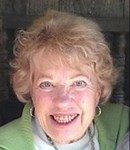 Donna W. Bailey-Thompson
Donna W. Bailey-Thompson
Donna W. Bailey-Thompson, 87, of Springfield, Mass., died Dec. 7 in East Longmeadow (Mass.) Skilled Nursing Center.
Bailey-Thompson was city editor of the former Springfield Herald in the 1960s.
In the 1970s, she was one of three co-founders of the former Springfield Magazine, of which she was associate editor.
She had been managing editor of Lady Seymour, based in Goldsboro, N.C., a magazine focused on the wives of U.S. Air Force officers. She also had been a teaching editor of the Spanish American Union, based in Springfield, Mass., and the bilingual newspaper, La Voz/The Voice, based in North San Francisco Bay.
In the 1990s, Bailey-Thompson launched a monthly publication, Challenges, about codependency.
She wrote her first musical review in 1958, and was a music and theater critic for nearly 60 years. She received a Lifetime Achievement Award from the Massachusetts Critics Circle in 2016. She hosted “Playbill,” a weekly radio show about the arts, in the 1960s.
Bailey-Thompson wrote two books, “Before,” about her childhood, and “Stark Raving Sober,” a memoir.
She also owned a public relations business, and was a freelance writer and creative writing coach.
She leaves a daughter, Elizabeth; a son, David; five grandchildren, David, Jason, Isabelle, William and Anne Marie; eight great-grandchildren; her ex-husband, William.
JoAnn Elizabeth (Carlson) Dolan
JoAnn Elizabeth (Carlson) Dolan, 85, of Clinton, Conn., formerly of Quincy, Mass., died Jan. 4 at The Connecticut Hospice in Branford, Conn., after a brief illness.
Dolan was a reporter for the former Clinton Recorder beginning in the 1970s and later became its co-editor during a 10-year career there. She also wrote columns for the Recorder.
She also was employed briefly with The Hartford (Conn.) Courant. She wrote feature stories for the New Britain Herald; Harbor News, which covers Clinton and Old Saybrook and Westbrook, Conn.; The New York Times; and Reader’s Digest magazine.
She leaves two sons, Christopher and Scott; two daughters, Tracey and Kim; six grandchildren; a great-grandson.
 Jonathan Michael Klarfeld
Jonathan Michael Klarfeld
Jonathan Michael Klarfeld, 80, died Jan. 8 after a month in Beth Israel Deaconess Medical Center in Boston.
Klarfeld was a journalism professor at Boston University for more than 40 years. He was still teaching at the beginning of the fall semester.
“He had no patience for students and their ‘creative’ writing,” Ally Jarmanning, a former student and newswriter for “Morning Edition” at radio station WBUR-FM, an NPR affiliate in Boston, said in a Boston Globe obituary on Klarfeld. “He was solely focused on teaching us to write and report in the model of an old-school newspaperman.”
Ronni Gordon, a freelance writer and another former student, said in the Globe obituary: “I like to say he ‘scared’ good writing into me, and it worked. He was tough, but fair.”
Tom Fiedler, dean of BU’s College of Communications at BU, said in the Globe obituary: “In more ways than I can express, Jon was the institutional memory of this college and of the journalism program, to which he gave his full passion. You can be certain that he helped transform the lives of thousands and thousands of students who are now in the communication profession because of his influence. He lives on in their work and their memories.”
Before teaching at BU, Klarfeld wrote for the former Holyoke (Mass.) Transcript-Telegram, United Press International in Springfield, Mass., The Boston Globe, and the former Boston Record-American. He wrote media reviews for the Boston Herald and restaurant columns for The Boston Phoenix.
He leaves his wife, Patricia; a daughter, Victoria; a son, Alexander.
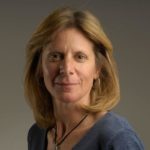 Lisa S. Chedekel
Lisa S. Chedekel
Lisa S. Chedekel, 57, of Newton, Mass., died Jan. 12 in Cambridge, Mass., after a long illness.
Chedekel began her journalism career in 1982 at the former New Haven (Conn.) Advocate. Two years later, she moved to the New Haven Register.
In 1992, Chedekel joined The Hartford (Conn.) Courant and a year later was on a team of reporters who won the Pulitzer Prize for breaking news coverage of fatal shootings at the Connecticut Lottery Corporation.
She took up political coverage in 2000. Her “Mentally Unfit, Forced to Fight” with Courant colleague Matthew Kaufmann was an investigative series that exposed the military as being in violation of its own rules by sending mentally ill soldiers to war in Iraq and Afghanistan. The series won the George Polk Award and the Selden Ring Award for Investigative Reporting and was a Pulitzer Prize finalist.
Chedekel left the Courant in 2008 and became a writer at Boston University’s School of Public Health and a journalism teacher at Northeastern University.
Chedekel was senior writer and co-founder of Connecticut Health Investigate Team
She leaves her wife, Dr. Isabel Morais, and two children, Bernard and Evelyn.
David P. MacKenzie
David P. MacKenzie, 71, of Springfield, Vt., died unexpectedly Jan. 5 at Springfield Hospital.
MacKenzie operated a small newspaper in the Burlington, Vt., area.
He also had been a technical writer at Bryant Grinder Co in Springfield.
He leaves his brother, Robert; Robert’s wife, Cheryl; several cousins.
Maureen McDonald
Maureen McDonald of New London, Conn., died Jan. 19.
McDonald was the editorial page editor at the Norwich (Conn.) Bulletin for many years.
She leaves her father, John; her husband, Kenneth; a brother; a sister.

Gloria Negri
Gloria Negri, 91, formerly of Scituate, Mass., died Dec. 10 in her home in Hingham, Mass.
Negri began her newspaper career at The Jewish Advocate, based in Boston, soon after she graduated from college. Later, she reported for the Daily Hampshire Gazette of Northampton, Mass., The Standard Times of New Bedford, Mass., and the Miami Herald.
In 1959, she joined The Boston Globe and was a reporter there for 53 years until her retirement in 2012.
“All the women in the newsroom owe her a debt of gratitude,” Patricia Nealon, a friend and editor at the Globe, said in Negri’s obituary in the Globe. “She really decided that all of the news pages would be open to her. All of us who followed, followed in her footsteps.”
Negri travelled extensively worldwide to cover stories for the Globe – and at least once in a submarine.
The Globe obituary noted that, among many others, her stories involved covering the launch of Apollo 11 at Cape Kennedy before the first moon landing; reporting from South Africa as apartheid began to come to an end; being on assignment in Fenway Park the day Ted Williams hit his last home run in his last game; writing from Hyannis, Mass., about Rose Kennedy as she cried in church the day after her son John was assassinated.
Negri received a Master Reporter Award from the New England Society of News Editors.
Stephen Kurkjian, a former Globe reporter and editor, said in the Globe obituary that as Negri regaled him with anecdotes about her reporting assignments, “I realized that she had covered the history of the end of the 20th century. It was always the same Gloria – notebook out, asking questions, getting as close as she could to where history was being made, whether it was in Vietnam or across the street from the Public Garden at the Ritz.”
Globe columnist Thomas Farragher said in Negri’s obituary: “There was another side of Gloria outside the Globe newsroom – a funny and inquisitive woman who my kids got to know as they shoveled her snow, cut her grass, and sat at her kitchen table drinking root beer. She became, without exaggeration, part of my family.”
Negri leaves no immediate survivors.
Terese Carol ‘TC’ Aronoff Karmel
Terese Carol “TC” Aronoff Karmel, 78, of Storrs, Conn., died Dec. 26 of congestive heart failure.
Karmel was a writer, journalist and educator in Connecticut for nearly 50 years.
She was a reporter for The Hartford (Conn.) Courant. She covered local news in its Mansfield, Conn., bureau in the early 1970s. She later covered the Bristol Red Sox, Hartford Whalers and other Connecticut sports teams.
Later, Karmel was a columnist and features editor for The Chronicle of Willimantic, Conn., and wrote for Connecticut Magazine of New Haven, Conn.
Karmel taught sports reporting courses at the University of Connecticut, and was an adviser in the journalism department there. She covered the University of Connecticut women’s basketball team for the Meriden (Conn.) Record-Journal.
She authored “Hoop Dreams: UConn Huskies Women’s Basketball.”
Her sports reporting also involved covering horse racing in national publications, including the online Blood-Horse Daily, based in Lexington, Ky.
She leaves two children, James and Allison; four grandchildren, Caroline, Naomi, Jillian and Juliette; a brother.
 Kerry Roy Mathias Kohring
Kerry Roy Mathias Kohring
Kerry Roy Mathias Kohring, 73, of Providence, R.I., died unexpectedly Dec. 3 at home.
Kohring was a copy editor for The Providence Journal and the Columbian (Mo.) Daily Tribune during his 40-year career.
In 1977, Kohring was a union member of the Providence Newspaper Guild. He engaged in contract negotiations.
After retirement in 2010, he became president of the Retired Members Council of the Providence Newspaper Guild.
He leaves his wife, Sandy; a son, Mathias; a daughter, Megan; two grandchildren; a brother.
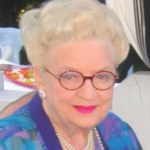 Vivian Berthe Firato Ferguson
Vivian Berthe Firato Ferguson
Vivian Berthe Firato Ferguson, 92, of Tolland, Conn., died Dec. 10 at Woodlake at Tolland Nursing and Rehabilitation Center.
Ferguson was food editor for the former Manchester (Conn.) Evening Herald, and wrote a weekly column called From Your Neighbor’s Kitchen. She later collected those pieces into four cookbooks.
Ferguson hosted a radio program on the former WINF-AM radio station in Manchester called “Vivian Ferguson’s Kitchen.”
Ferguson was elected to the Manchester Board of Directors, where she served for several years. She was also a member of the Manchester Republican Town Committee for 50 years.
She leaves a son, Thomas; two daughters, Leigh and Laurie; five grandchildren, Thomas, Marissa, Elisabeth, Brett and Alyssa; a sister.
Nancy Evelyn LaRoche
Nancy Evelyn LaRoche, 80, formerly of Wethersfield, Conn., died Dec. 5 in St. Francis Hospital in Hartford.
She was an editor in the features department of The Hartford (Conn.) Courant, and was an editor of reference books before that. She was employed at the Courant until 1995, and became a freelance editor.
She leaves several cousins and four godchildren.
Josiah Bridge
Josiah Bridge, 90, of Stamford, Conn., died Dec. 30 at home.
Before he became a high school teacher, Bridge was sports editor and a reporter, columnist, and photographer for the Southbridge (Mass.) Evening News, and he reported on local news and wrote features for The Advocate of Stamford, Conn.
Bridge was active in politics. For several years, he was on the Democratic City Committee. He was manager for the campaign to elect Democrat Paul Shapero to the Connecticut House of Representatives. He was publicity manager of Bruno Giordano’s mayoral campaign in Stamford.
Bridge was a published author. His work appeared in magazines such as the South Boston Literary Gazette and others nationwide.
He leaves four children, John, Barbara, William and James; two grandchildren, Thomas and William; a sister.
 Ralph D. Paight Jr.
Ralph D. Paight Jr.
Ralph D. Paight, Jr., 94, of Palm City, Fla., and formerly of Stamford, Conn., died Dec. 22.
He began his newspaper career in 1951 at the Greenwich (Conn.) Time. During his 20 years there, he advanced from apprentice pressman to foreman. He then joined, for 15 years, the staff of The Advocate of Stamford.
Paight leaves two children, Donald and Donna; four grandchildren, Steve, Kelly, Chris and Kathryn; six great-grandchildren.
Clause J. Dixon Jr.
Clause J. Dixon Jr., 92, of Stamford, Conn, died Jan. 7 at Stamford Hospital.
Dixon was a reporter, columnist and feature writer for the former Connecticut Sunday Herald of Bridgeport, Conn., the Bridgeport Sunday Post, and a copy editor for the then-Bridgeport Telegram.
He was an on-air reporter for the WGCH-AM of Greenwich, Conn., and WSTC-AM of Stamford.
Dixon leaves a son, Kenneth, State Capitol reporter and columnist for Hearst Connecticut Media, based in Norwalk, Conn.; a daughter, Jean; two grandchildren, Peter and Julia; a great-grandson, Owen; two brothers.
 Nancy L. (Boucher) Veilleux
Nancy L. (Boucher) Veilleux
Nancy L. (Boucher) Veilleux, 74, of Hooksett, N.H., died Dec. 31 in Concord (N.H.) Hospital after a long illness.
For 19 years, Nancy was a reporter and photographer for the Hooksett Banner.
She leaves her husband, Robert; four children, Wendy, Donna, Bruce and Michael; eight grandchildren; a sister.
Lewis G. Joslyn
Lewis G. Joslyn, 91, of Center Barnstead, N.H., died Dec. 12 in his home.
He was a reporter and photographer for the New Hampshire Union Leader of Manchester, N.H., the Haverhill (Mass.) Journal, and The Haverhill Gazette.
He leaves a son, Glenn, and many cousins and nephews.
 Mike McGraw
Mike McGraw
Mike McGraw, 69, of Kansas City, Mo., died of cancer Jan. 6 at NorthCare Hospice in North Kansas City.
McGraw, a Pulitzer Prize-winning reporter who spent most of his career at the Kansas City Star, was earlier labor editor at The Hartford (Conn.) Courant.
He began his 45-year journalism career in 1972.
McGraw was a business and labor writer at The Des Moines (Iowa) Register.
For most of his career at the Star, where he was employed for 30 years, he was an investigative reporter and on the Star’s special projects desk beginning in 1989. He also was an editor and bureau chief at the Star. He retired from the Star in April 2014.
After his employment at the Star, he was a projects reporter for Kansas City-based KCPT television’s The Hale Center for Journalism. His other work was with NPR and Kansas City-based KCUR-FM’s Harvest Public Media, for which he covered Midwestern agriculture and agribusiness.
Even after his retirement, projects and columns of his were published in the Star.
McGraw received many honors, including a top award from Investigative Reporters and Editors, two George Polk Awards, the Robert F. Kennedy Journalism Award, and a 1992 Pulitzer Prize for national reporting for “Failing the Grade: Betrayals and Blunders at the U.S. Department of Agriculture.”
He had been a member of the Investigative Reporters and Editors board, and contributed to its Reporter’s Handbook.
McGraw taught investigative reporting at the University of Missouri and the University of Kansas, and was a Ferris professor in residence at Princeton University.
He leaves his wife, Ruth; two sons, Andy and John; four grandsons.
Lawrence G. Weiss
Lawrence G. Weiss, 97, of Boulder, Colo., died Jan. 10 in Boulder.
Before moving to Boulder, in 1954, Weiss was a reporter for the Boston Herald and a writer for The New York Times. He also was a special assistant to the U.S. secretary of labor.
From 1958 to 1975, he was an editorial writer for The Denver Post.
He taught journalism at the University of Colorado before joining the Post, and continued to teach evening honors courses there for 18 years.
After he left the Post, he became special assistant to the governor of Colorado.
From 1977 until he retired in 1985, Weiss was director of public affairs for the Colorado and Denver bar associations.
He leaves his wife, Rita; a daughter, Carolyn; a son, Jonathan; three grandchildren; eight great-grandchildren; a sister.
Saul Freilich
Saul Freilich, 90, of Wallingford, Conn., died Dec. 25 at Midstate Medical Center in Meriden, Conn.
He wrote for the New Haven (Conn.) Register and was employed after that with the then-Springfield (Mass.) Union. Freilich later wrote for the Meriden Record-Journal.
Freilich initially was a journalist in Lewistown, Mont., before joining a newspaper in Middletown, N.Y.
He leaves his wife, Naomi; a son, Jeffrey; a daughter, Franci; two brothers.
Anthony J. ‘Tony’ Matejczyk
Anthony J. “Tony” Matejczyk, 81, of Thorndike, Mass., and formerly of Framingham, Mass., died Jan. 12 at home.
Matejczyk was a Massachusetts journalist for years, for the then-Springfield Union and Boston Herald
He later was a public relations executive with Verizon Boston.
He leaves his wife, Mary Pat; three children, Anthony, Elizabeth and Michael; three grandchildren.
Lloyd E. Banquer
Lloyd E. Banquer, 86, died Dec. 6 in Fairfield, Conn..
Banquer was a reporter for The Day of New London, Conn., for eight years.
He was a senior editor in internal communication for IBM for 25 years.
He leaves two children, Douglas and Karen, and four grandchildren, Alex, Jake, Lauren and Kelsey
 Shirley M. (Martin) Kimball
Shirley M. (Martin) Kimball
Shirley M. (Martin) Kimball, 91, of Shrewsbury, Mass., and Saco, Maine, died at home Jan. 9 after an illness.
She was a reporter for the Telegram & Gazette of Worcester, Mass, and later became a freelance writer of travel stories.
Kimball leaves her husband, Ralph; three sons, Kevin, Brian and Neal; three grandchildren.
Clarice Bianchi Cella ‘Mickey’ Best
Clarice Bianchi Cella “Mickey” Best, 83, died Nov. 22 at her home in Wallingford, Vt.
Best was briefly a reporter for The Barre Montpelier (Vt.) Times Argus.
She leaves her husband, Robert; an adopted daughter, Jill Burkett; a sister.
 Pedro A. Espinoza
Pedro A. Espinoza
Pedro A. Espinoza, 83, of Windsor, Conn., died Dec. 18 in Windsor.
Espinoza was a reporter for El-Salvador-based La Prensa Grafica, which was the first bilingual Latin American newspaper distributed in New England.
Soon, he became co-editor of Que Pasa, which has headquarters in Winston-Salem, Raleigh and Charlotte, N.C.
While with Que Pasa for 15 years, he launched a Spanish-language radio program at Trinity College’s station, WRTC-FM in Hartford, Conn.
Espinoza leaves three children, Carlos, Janet, and Yvonne, and four grandchildren, Tasya, Leila, Yasmine and Emile.
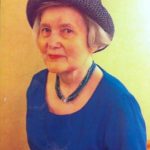 Solace (Walker) Tobey
Solace (Walker) Tobey
Solace (Walker) Tobey, 76, of Hingham, Mass., died of multiple myeloma Jan. 16 in her home.
She was a town reporter for the former Hingham Mirror, the former Hingham Mariner, and The Patriot Ledger of Quincy, Mass.
She leaves her husband, Philip; a daughter, Elizabeth; a son, Robert; a brother.
Lois J. MacDonald
Lois J. MacDonald, 86, of Quincy, Mass., died Dec. 30 at Seasons Hospice in Milton, Mass., after a brief illness
She began her career in newspaper sales and advertising with what is now the Boston Herald. She then was employed at The Boston Globe in classified advertising for many years. In 2010 she retired as a classified advertising representative with GateHouse Media New England at The Patriot Ledger of Quincy and The Enterprise of Brockton, Mass.
She leaves two children, Kristin and Andrew; three grandchildren, Penelope, Gwyneth and Piper; two siblings.
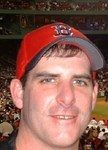 Paul Niles Flanders
Paul Niles Flanders
Paul Niles Flanders, 48, of Worcester, Mass., and formerly of Beverly, Mass., died unexpectedly Dec. 29 at the University of Massachusetts Memorial Medical Center in Worcester.
Flanders was employed by New England’s largest newspaper chain and its successor, Community Newspaper Company and GateHouse Media, since 1992 in the Danvers, Beverly and Framingham, Mass., offices. He had various jobs there, including proofreader, advertisement builder, paginator and pre-press technician.
He leaves his mother and father, Diane and Niles; his wife, Jan; a sister, Hilary.
Edward Snowden Robinson
Edward Snowden Robinson, 69, of Boston died Jan. 16 after a lengthy illness.
He was an apprentice at Daniels Printing and later at the Boston Herald.
Robinson leaves his wife, Alice; five children, Eddie, Jerrell, Terez, Eric and Alex; two grandchildren; five great-grandchildren; two sisters; a brother.
Rosemary M. (Walsh) Cronk
Rosemary M. (Walsh) Cronk, 90, of Fairfield, Conn., died Jan. 12 in Cambridge Manor in Fairfield.
Cronk was a pasteup artist for Brooks Community Newspapers, a chain of weekly newspapers in Southwestern Connecticut.
She leaves a daughter, Karen; a son, Bruce; three grandchildren, Jaimee, Todd and Jenna; three great-grandchildren, two brothers.
Raymond Quentin Levesque
Raymond Quentin Levesque, 70, of Boscawen, N.H., died Jan. 12 at the Concord (N.H.) Hospice House after battling cancer.
Levesque was a contributing writer for the Concord Monitor.
Levesque leaves his wife, Rebecca; three children, Dan, Mark and Marie; four grandchildren; a brother; a sister.
 Thanas ‘Arthur’ Laske
Thanas ‘Arthur’ Laske
Thanas “Arthur” Laske, 89, of West Hartford, Conn., died Jan. 2 in Hartford (Conn.) Hospital.
Laske contributed to the publication of the former Liria, an Albanian-American newspaper in Boston.
He leaves his wife, Aliki; a son, Apostol; three grandsons.
 Eleanor ‘Jane’ (Begiebing) Robare
Eleanor ‘Jane’ (Begiebing) Robare
Eleanor “Jane” (Begiebing) Robare, 90, of Stamford, Vt., died Dec. 15 at home.
Robare was a freelance journalist for the then-North Adams (Mass.) Transcript. She reported on Vermont news until 1966.
She leaves her husband, Edward; a son, Bruce; a daughter, Judith; three grandchildren; three step-grandchildren; three step-great-grandchildren.
Robert Elmer Brackley
Robert Elmer Brackley, 79, of Strong, Maine, died Nov. 29 at Franklin Memorial Hospital in Farmington, Maine.
Brackley delivered the Sun Journal of Lewiston for 25 years.
He leaves his wife, Kay; a daughter, Gayle; three sons, David, Daniel and Robert Jr.; 24 grandchildren; 22 great-grandchildren; a sister.
Joan Marie (Ardini) Cawley
Joan Marie (Ardini) Cawley, 87, of South Burlington, Vt., died Dec. 6 after a lengthy illness.
She was employed with the former Boston Herald Traveler and in customer support for Camden House Publishing, based in Rochester, N.Y., and Eating Well magazine of Charlotte, Vt. She retired in 1993.
She leaves three sons, Ed, Tom and Jon; two daughters, Lisa and Laura; nine grandchildren, Stephany, Ashley, Justin, Jordan, Matthew, Hannah, Patrick, Elise and Cole; two great-granddaughters; two sisters.
Sheila Jane Kerr (Haglund) Swenson
Sheila Jane Kerr (Haglund) Swenson, 84, of Kennebunk, Maine, died Jan. 9 in her home.
After moving in 1974 to Kennebunk, she began to edit her husband’s columns, and his books for national publishers. In 1957, before moving to Kennebunk, Swenson had been a co-author of the Gardener’s Notebook columns, syndicated in more than 200 U.S. newspapers.
With her husband, Allan, she frequently participated in his syndicated “Gardener’s Notebook” radio talk shows based in New York City.
Besides her husband, she leaves four sons, Peter, Meade, Boyd and Drew, and nine grandchildren, Parker, Katie, Alyssa, Erik, Trevor, Casen, Sam, Tony and Luca.
Charles Beebe ‘Chuck’ Dudley
Charles Beebe “Chuck” Dudley, 76, of Stowe, Vt., died Jan. 18 at The Manor in Morrisville, Vt.
Dudley wrote the Stowe Community Church’s news published in the Stowe Reporter.
He also wrote a book entitled “The Stowe I’ve Grown to Know,” a history of the families and neighborhoods of his hometown.
Dudley leaves a sister, Betty; a brother, Miles; two cousins; six nieces and nephews.
Julian M. ‘Bodie’ Bodenheimer
Julian M. “Bodie” Bodenheimer, 100, of Stamford, Conn. died Jan 3.
His cartoons were published in newspapers and other publications.
He leaves his wife, Vivian; two children, George and Susan; six grandchildren; a great-grandson.
The obituaries were written, at least in part, from published reports by Bulletin correspondents Ajoa Addae, Nadine El-Bawab, Angela Gomba, Nico Hall, Julia Hutchins, Joshua Leaston, Kaitlyn Mangelinkx, Sydne Garcia, Monica Nair, Rebekah Patton, Mohammed Razzaque, Casey Rochette, Cayley Ross and Thomas Ward, undergraduate students in the Northeastern University School of Journalism.

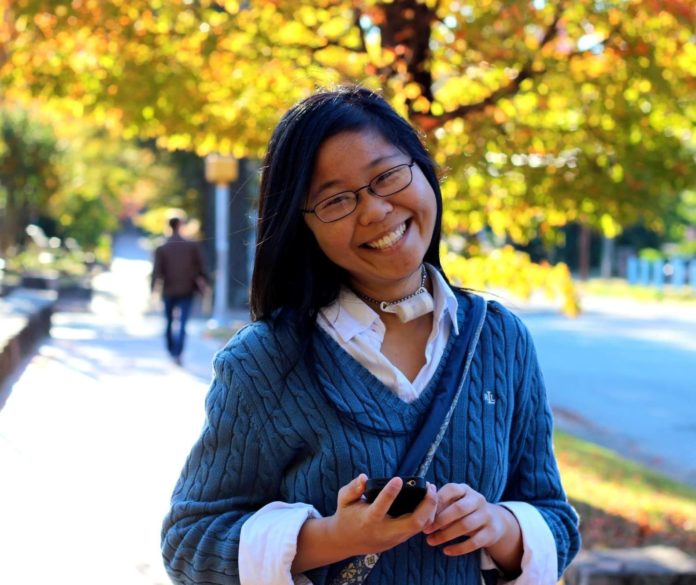

 n journalism, “people with disabilities are often an afterthought,” included only in features instead of throughout regular reporting. Lu thinks that “we need to see more coverage of disabled athletes in sports, and we need to do more reporting on accessibility in schools. There’s a ‘disability angle,’ if you will, in practically every story.”
n journalism, “people with disabilities are often an afterthought,” included only in features instead of throughout regular reporting. Lu thinks that “we need to see more coverage of disabled athletes in sports, and we need to do more reporting on accessibility in schools. There’s a ‘disability angle,’ if you will, in practically every story.”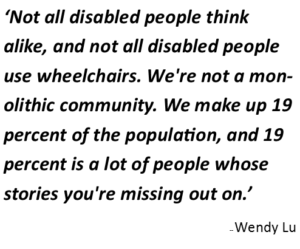



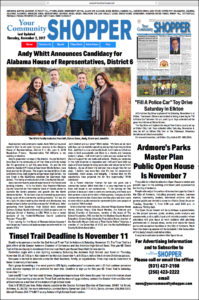 “It is time-intensive now, while I’m learning the software. However, as I put less new material on the site and build a way for people to subscribe to the newspaper, I think the site will become much easier to update. I’m still deciding what I want to be standard information they can count on seeing every week and what will not be there. I’m starting to find that less is actually more.”
“It is time-intensive now, while I’m learning the software. However, as I put less new material on the site and build a way for people to subscribe to the newspaper, I think the site will become much easier to update. I’m still deciding what I want to be standard information they can count on seeing every week and what will not be there. I’m starting to find that less is actually more.”

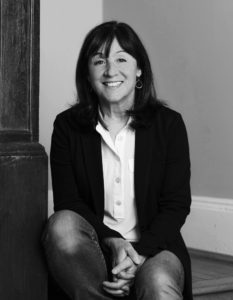

 Christopher
Christopher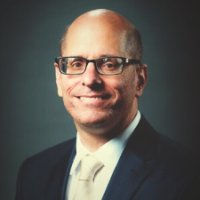
 Diagnosed with a rare eye disease that left him legally blind at a young age, David D’Arcangelo has built successful careers in both the public and private sectors and now serves the Baker-Polito Administration as the Director of the Massachusetts Office on Disability.
Diagnosed with a rare eye disease that left him legally blind at a young age, David D’Arcangelo has built successful careers in both the public and private sectors and now serves the Baker-Polito Administration as the Director of the Massachusetts Office on Disability.
 Al Getler has worked with nearly 100 New England publications and has served as publisher of five daily and four weekly newspapers. As publisher of The Eagle-Tribune (North Andover), his team reinvented their website and apps as early adapters bringing the mobile readership to above 50% as early as 2013. He launched the creation of a string of magazines in the North of Boston Media Group and, most recently, a ski magazine in Vermont. His team developed a LiveStream show at the Burlington Free Press titled ‘The Table’ covering topics such as human trafficking, the opioid crisis, and homelessness with guests including governors, members of congress and community leaders. His Burlington team was video centric having won 5 Edward R. Murrow Awards from The Radio Television Digital News Association. Getler believes that newspapers need to push the digital envelope, especially video, while remaining true to the mission and tradition of newspaper journalism.[/vc_column_text]
Al Getler has worked with nearly 100 New England publications and has served as publisher of five daily and four weekly newspapers. As publisher of The Eagle-Tribune (North Andover), his team reinvented their website and apps as early adapters bringing the mobile readership to above 50% as early as 2013. He launched the creation of a string of magazines in the North of Boston Media Group and, most recently, a ski magazine in Vermont. His team developed a LiveStream show at the Burlington Free Press titled ‘The Table’ covering topics such as human trafficking, the opioid crisis, and homelessness with guests including governors, members of congress and community leaders. His Burlington team was video centric having won 5 Edward R. Murrow Awards from The Radio Television Digital News Association. Getler believes that newspapers need to push the digital envelope, especially video, while remaining true to the mission and tradition of newspaper journalism.[/vc_column_text]
